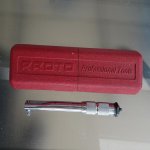Physics lesson!
A bolt works just like a C-clamp (with a really skinny C).
Picture a couple of 2x4's that have been C-clamped together at their ends.
If you try to shear the joint between them (by trying to pivot it) it is the friction of the wood faces that resists. The loading on the C-clamp doesn't change until you pry so hard that the friction joint slips (at which point it won't help much).
If you try to push the wooden faces closer together the loading on the C-clamp doesn't change at all until you crush the wood.
If you try to pull the wooden faces apart the loading on the C-clamp only changes (significantly) once the pull force is higher than it's clamping load. Until then all you're doing is decompressing the wood joint.
The concept of knowing when "load change" on the C-clamp happens is key because bolts are stretchy.
Picture a nut and bolt assembly but instead of steel they are made of rubber.
When I torque them up the bolt is in tension and the nut is in compression. So the bolt gets stretched longer and the nut gets squashed shorter. But, you also know from experience that when stretched rubber gets thinner, and when squashed it gets wider. So the threads of the nut expand outwards while the threads of the bolt shrink inwards.
When the bolt was originally torqued up that isn't a problem (well, it is actually, but its one we know how to deal with) but consider what happens if the load on the bolt changes in service.
Every time the tension on the bolt increases the bolt shrinks in a bit more and the nut spreads out a bit more. Every time the tension on the bolt decreases the bolt grows back out and the nut shrinks back in. They can't both change shape together, so once the differential force from grow/shrink gets high enough the joint faces of the thread slide on each other. In a bit, out a bit, with every change in tension large enough to break the thread face friction.
And every time they slide a bit radially they also have the opportunity to slide back a bit along the thread incline. Because once a friction joint starts to slip (like fishtailing your motorbike) it stops being directional and is free to move from even small off-axis loads.
The name of the game in bolted joint design is to prevent the load on the bolt changing enough for the differential movement to overcome the thread face friction, because once it changes enough to do that the thread will start to move and loosen up.
If the bolts are big enough and torqued correctly then the clamping force is high and all loads and load changes are borne by the surfaces of the clamped joint. The tension in the bolt never changes significantly, nothing moves, and the joint survives (basically) forever with no thread locking chemicals/fittings being required. This is what we call a well-engineered joint, and your car is full of them.
If the bolts are under-sized or under-torqued the joint will slip or separate and the loading in the bolt will vary, and the stretch-wiggle dance will start to loosen the thread. Once the thread starts to loosen clamping force drops further and the process self-accelerates. You'll have seen this yourself; bolts that last for years but then go from "Looked fine yesterday" to rattling loose in a short time.
Gluing* the nut onto the bolt will prevent it from loosening, but it is a workaround that doesn't solve the underlying problem of the joint or how it was assembled.
Now, there may be times when a workaround is warranted. A joint where a big-enough bolt won't fit or torque can't be controlled and I'm OK with it moving a bit occasionally, or when a loose bolt is a much smaller problem than a missing bolt (like a wheel hub nut), or when occasional combined shock/temperature loading is too high for friction to resist and other features (like pins) are locating the joint, or when minimizing unsprung mass is critical.
Your car will have a handful of places where this is done, but not many.
Or maybe the chassis are already fielded and reports come back of an under-sized screw working its way loose. A bulletin telling the techs to glue that screw in will be cheaper than a recall.
But now you have to deal with the thread locker. And it being expired (1 year shelf life? Seriously?). And it migrating or outgassing to other surfaces of the assembly (its absolute poison for optical assemblies). And it not being cleaned out properly during re-work. And chemical toxicity issues (loctite is a sensitizing skin toxin).
Going back to the c-clamp example. Epoxying the threads on the c-clamps will prevent them from loosening when the boards move, but it is not the preferred answer. Driving a couple of nails through the boards too will prevent them from twisting, but is not the preferred answer. The preferred answer is "Get bigger C-clamps, locate them correctly, tighten them good and hard and the boards won't move."
I think the above ties together a bunch of previous postings.
-Well-engineered joints don't need locking elements/chemicals.
-Loctite kills warranty on optics
-Torque control is critical for reliable joints.
I skipped talking about stiffness ratios, which explains why short-fat bolts don't stay torqued as well as long-thin ones, but that's a tough subject to crack in a non-technical briefing. I skipped talking about nut/bolt behaviour in shear failure because by that point you've already lost.
*loctite is a single component thermoset glue who's hardening is catalyzed by active metal but is inhibited by oxygen. Put it into a thin deep gap between metal parts, rub those parts together hard to scrape off the oxide layer, and it will harden.










































































